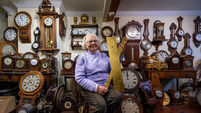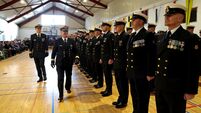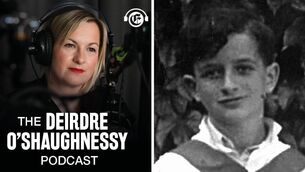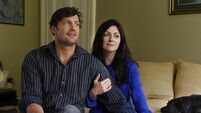Settlement money is 'not a lottery win' — Solicitor says every family's case has its own story

Aileen Gibson, mother of Lee Gibson, with her solicitor Orla Kelly after the High Court approved a €20m final payment on behalf of Lee Gibson in 2019. Picture: Collins Courts
Three medical negligence cases, three unnecessarily long legal battles with the HSE, and three landmark rulings. examines the human stories behind each case and talks to three solicitors who helped the families get justice and access the life-lengthening and life-enhancing therapies and care they need for the rest of their lives.
Strapped into a pinching wheelchair, his head lolling uncomfortably to the side, little Lee Gibson was shrinking back from the world as he grew, rather than running boisterously towards it like most children his age.
He could not control his limbs due to cerebral palsy, muscle spasms caused him near-constant pain, he could not talk, and he relied on family and a wheelchair to move.
But now, just a few years later, Lee is a smiley, happy 15-year-old whose “cheeky personality" has fully emerged thanks to computer technology which is allowing him to communicate freely for the first time, along with years of therapy and support.
“He was unable to communicate and he was in constant pain,” said his solicitor, Órla Kelly, who helped Lee and his devoted mother, Aileen, secure the State’s largest settlement for its type of action — €23m — in November.
“But now he smiles and says ‘hi’ through his specially-adapted computer when you visit the house, or he waves and says ‘bye-bye’ when you’re going through ‘boring’ paperwork with his mum. His cheeky personality is coming through.
His mother Aileen, 33, from Carrigaline, Co Cork, sued the HSE over the circumstances of Lee's birth, claiming that he suffered brain damage at St Finbarr’s Hospital in Cork on July 5, 2005.
A lack of oxygen and the effect of an untreated infection suffered by his mother left the baby with multiple brain injuries, it was claimed.
There was also an alleged delay of between 91 to 106 minutes before delivery by emergency caesarean section once the decision for the caesarean had been made.
It was further claimed that there was a failure to treat the case as an emergency and to give a candid explanation for what happened and why.
The claims were denied — but after a long, stressful, expensive, and adversarial legal battle, liability was settled by the HSE with a final, once-off lump sum of €20m.
But interim payments of €2m and €1m prior to this allowed Lee to access important and timely treatment which has greatly improved his life.
When approving the first €2m interim settlement for Lee in October 2015, Mr Justice Kevin Cross said that sometimes litigation is “the only way to achieve” justice.
And when approving the final figure, the president of the High Court Mr Justice Peter Kelly paid tribute to the teenager’s mother and paid tribute to her for the excellent care she had given him.
Lee’s mother Aileen said that the day was “bittersweet” because "money could not change what happened to Lee".
But it has allowed Lee to access care, therapies, and equipment which have radically transformed his life.
“Before therapies, Lee's communication was minimal, limited to lámh sign language which, of course, not everyone can understand,” Aileen told the . "He was also relying on a lot of pain medications, which in turn reduced his quality of life.
“That all changed rather quickly after the first court case.
“We hired the physiotherapist and he had much more access to therapy.
“Before the extra physio, he was on Fentanyl and morphine daily — very strong pain medication — and numbing patches on his legs. He was highly sedated, which he hated, and was in a lot of pain. But all those medications were gone after 12-18 months of weekly physio.
“He's now meeting his potential right across the board. He’s communicating with his device, holding conversations, ordering for us while we eat out.
“But thanks to the case, he’s not going to fall behind anymore. And he will be able to live as independently as you can as a quadriplegic.
“The final court judgment was bittersweet. Lee was injured — it doesn’t take that away. But the therapies he’s been able to receive since will extend his lifespan. If we didn’t have that money, I don’t know what would happen."
She said the money from compensation is handled by the High Court.
“The money is not a lottery win," she said. "It’s managed by the High Court, which is a weight off my shoulders, and I can just concentrate on getting Lee to a good place.
“And despite everything he’s been through, he’s the most positive person I ever met.
“I can't emphasise enough the change in him. He’s blowing us away this year. He’s a go-getter and a fighter. It’s so exciting when you know that there’s no limit to your child’s potential.
Lee’s vast improvement is due to the dedication of his family and the money secured through litigation which has allowed Lee to access the therapies and equipment which have so radically improved his life.
“Families couldn’t afford this privately,” said Ms Kelly. “The HSE says that it provides things like physiotherapy, but the reality is that the service is too stretched.

“It’s distressing and frustrating when the HSE defends itself and says it provides these things, when parents know that these services are not readily available unless they can pay for them.”
Noting the improvements in Lee over the years, Ms Kelly said: “Lee’s left arm would flail around, he had no control over it, it was like a dead arm. It would hit things, it could hit someone in the face. It was a liability.
“He had physiotherapy and occupational therapy which worked on controlling his arm and easing his pain. Now his left arm is his friend, not his enemy. But he would not have got that level of care publicly through the HSE."
'
She said the headline-grabbing figures like Lee’s settlement may seem “like a Lotto win” to people, but every cent is carefully accounted for.
“When you add up approximately 50 years of 24/7 care, adaptive technology, an adapted house, you get into the millions very quickly,” she said.
“Lee Gibson was catastrophically injured, but our various medical experts predict that he will live into his 60s. He had his first interim settlement of €2m because his needs were changing and we couldn’t predict how long he’d live.
“You could really see the good that money did. Early intervention is so important. His progress is phenomenal because he got help at the right time.
“You see the good it does when they get the money young, but on the flip side, you see the cases when they get the money when they’re 20 or 30.
“They miss the opportunity to walk and talk because they had to wait until the case ended to access money.
“I’ve seen an injured little boy walk after they got in there early with therapies and support, and another little boy with a similar condition who didn’t get that support early on and couldn’t walk."
She said the was an onus on the HSE to admit liability earlier.
“And the HSE will drag out the case for years, saying: ‘We did nothing wrong’, then four years later, they’ll say: ‘Oh, OK, actually we did.’
“If the HSE could admit liability sooner, we could just focus on how much the client needs and get them help much quicker.”

Lee is a ward of court, so the State is responsible for him and for the settlement money.
Ms Gibson gives Ms Kelly receipts for everything purchased. Medical experts agree on what is needed, the president of the High Court sanctions the payments, and the State invests the money, providing dividends, interest, and returns.
“There’s a lot of admin,” said Ms Kelly. "You’re not just given €23m to go to Disneyland.
“All the money they get is because of the injury, the aim of any case is to put the plaintiff back in the position financially that they would have been without the injury.
“So, if Lee needs new tracksuits or normal food, that’s not covered because that’s a normal life expense. But if he needs special pureed food due to his condition, or extra heating for the house because he gets so cold, that is covered.
“Someone said to me once after ‘winning’ their case: ‘I hate the word ‘win’. We didn’t ‘win’ anything, we just got the money needed to care for my child.' ”
Ms Kelly, who worked as a pharmacist before retraining in law, was still a trainee when she first met Lee and his mother at Cantillon’s Solicitors.
“I think Aileen would say that pursuing a case was daunting," she said. "She didn’t know a solicitor, she was a young mum. She called the offices, she came in. She told her story and said she felt so relieved, it was a weight off her shoulders.
“We told her to leave it with us and we’d investigate. She said that it was taken out of her hands, which was a bit of an unburdening."
Ms Kelly said that despite a sometimes-negative perception of her job, she loves her work.
“We make the case," she said. "We gather all the evidence, pull it all together, and present it.
"We only represent plaintiffs, so we create something rather than knocking something down. I like that you can help people, but also that you create something.
“All our clients have different stories, but with the same common threads. They’re all distressing and they all found it difficult to come in to us. Our job is to tease out the story.
“Only a small fraction will sue. An expert doctor must say that ‘no reasonable doctor would have done what they did’ for there to be a case. We don’t decide who can take a case — a medic does."
Ms Kelly was quick to praise the medical profession for their lifesaving work, and said that she and her colleagues are only called on to help when things very occasionally go wrong.
“We’re not anti-healthcare workers,” she said. “99% of them — the doctors and nurses — are brilliant. I’ve just had a baby myself, and I couldn’t praise them more.
“But what we work on is the small percent of cases where something does go wrong. A lot of the people who come to us say: ‘I never thought I’d be the person to sue, but I have no choice. I feel it’s my duty to get money for my child.' ”
Ms Kelly said that ideally, errors would be avoided in the first place, and she believes that litigation is one way to build more care into the medical system.
“If you highlight an error, hopefully that error will never happen again,” she said.
“That’s the best reward. If it changes practice. Like CervicalCheck — hopefully smear tests are all accurate now. Because we want some good to come out of this tragedy.”
Ms Kelly said that all of her cases — no matter how big or small — impact her.
"It hits me when you think: ‘This person lives in pain now forever because they severed a nerve in their finger’, or 'This woman survived cervical cancer after a misread smear but she lost her job, her relationship, her self-confidence'.
"All of them resonate with me. And you build up a relationship with your clients because you build the case over a few years. At the end, you get updates from people.
"Or they’re using the therapy well, and they’re really improving.
“I’ve had pictures of people from the swimming pool where they’re doing aqua aerobics to help them. That’s why I like it, and that’s why I do it. All the cases mean something.”
Looking down at their beautiful, “perfect” baby, Margaret Hurley’s parents could not believe the doctors who told them that their little girl would never walk or talk.
Margaret was diagnosed with spastic quadriplegia, and 19 years after that diagnosis in Crumlin Children's Hospital, she still cannot speak, and relies on a wheelchair.
“They really had no idea that things were going to be so tragic for them,” said Lyndy Cantillon, partner at Cantillon’s Solicitors in Cork who discovered that medical shortcomings around the time of Margaret’s birth may have catastrophically injured the child.
The Hurleys were never told before then that mistakes had been made before Margaret was born which may have badly injured her.

Had they been told sooner, Margaret, from Skibbereen Co Cork, could have accessed therapies at a younger age which may have helped her development.
Just as Margaret reached adulthood, she successfully sued the HSE through her mother Claire. They settled the case for €11m before it could get to court, but the HSE never admitted liability.
Remembering her first meeting with the Hurleys, Ms Cantillon said: “These two lovely people came in to meet with me. Margaret was 15 then.
“I remember the dad, a really nice man, a farmer, saying to me that they did not believe it when they were told that Margaret would never walk or talk.
“She was just the most beautiful baby and she seemed so perfect. He always believed that she would walk and talk, that it was going to happen.
“They came to us still not really knowing that any faults had occurred during the pregnancy or the delivery.
During her investigations, Ms Cantillon discovered that Margaret’s mother, Claire, had high blood pressure on February 28, 2000, days before Margaret was born.
'A red flag'
Hypertension is “a red flag” in pregnancy because it can put undue pressure on the foetus. It requires close monitoring in pregnancy, but Mrs Hurley was not monitored.
Ms Cantillon also alleged that there were failures to adequately calculate the estimated date of delivery; to admit Mrs Hurley for observation and to induce the labour at an earlier point in time.
“There was also some confusion with her estimated date of delivery, so she was left go two weeks overdue," Ms Cantillon said.
“It was only when we investigated the case that we brought those issues to light. That was the first revelation for them that something had gone wrong, that someone had taken their eye off the ball. That in itself is just unbelievable — that I, as a solicitor, had to deliver that news.
“It is something that will stick with me. Margaret was, unfortunately, someone who missed out on early intervention because her parents were unaware that anything went wrong.
"Because Margaret’s case wasn’t investigated until she was 18, a lot of the deterioration was undoable at that point, which was really sad to see. This was a really tragic case."
Margaret was the firstborn child to Claire and Gerald Hurley. They were thrilled to be pregnant in 1999, and Mrs Hurley attended her GP and travelled to all the usual appointments as a public patient in the now-closed Erinville Maternity Hospital in Cork City, which was a significant distance from her rural home.
“She had a scan at about 20 weeks and everything was fine,” said Ms Cantillon.
“So the pregnancy itself was no problem up until February 28, 2000, when she attended for her usual gynae appointment in the Erinville, and in that it was noted that she had high blood pressure.
“Usually when someone has high blood pressure in pregnancy, it has to be monitored — but she was sent back home and given a date for an induction if nothing happened in the meantime.”
But Mrs Hurley went into labour with Margaret about 24 hours before the induction date.
“She travelled on the old Cork road in labour, when she got to the hospital the labour was quite fast. Margaret was born on March 1, 2000.
“She [Mrs Hurley] was thrilled. A few complications were evident immediately to the doctors, but not to mum and dad.
“She was kept in the neonatal unit for almost two weeks, but the mum and dad were not aware that anything was too serious.”
A CT scan in Cork University Hospital in those first two weeks revealed some brain damage, but the Hurleys were not told.
Seven months later, Mrs Hurley noticed that Margaret had some jerking movements which “didn’t seem right”. She also noticed that Margaret never reached up to grab her glasses the way babies normally would.
Her GP referred her to Crumlin Children’s Hospital and it was only then, when Margaret was seven months old, that the Hurleys were told that their daughter had severe brain injuries.
“Margaret is 20 now," said Ms Cantillon. "She has spastic quadriplegic cerebral palsy. She can’t walk or talk. She can vocalise some sounds. You would know when she’s in distress.
“But she definitely has cause and effect. She was aware when I was speaking to her. She has a great relationship with her parents and her siblings.
"Margaret’s parents did an amazing job for 18 years, they did all they could do, but it’s sad to think that she could have had physio for 18 years, she could have had speech and language therapy for 18 years, she could have had a proper bed — so many things that she could have had if they had known that something had gone wrong.
“Margaret had a number of orthopaedic surgeries on her legs because her muscles had become so constricted and tight. If physiotherapy had occurred to keep those muscles looser, then perhaps some surgeries like that could have been avoided.
“They are such a really lovely family, but were unaware for so long about what happened, and that’s really sad for me.”
Ms Cantillon said that Margaret’s case was “fought tooth-and-nail until the bitter end”.
They were invited to mediation about one month before the case was listed for a court hearing.
“The case settled for €11m, but with no admission of liability from the HSE, which is crazy really," she said. "An admission of liability would have been a big thing for the family.
“It’s part of the whole HSE ‘deny and defend’. But if they admitted liability at a certain point, it would speed up the process and it would reduce costs.
“We investigate the case and so do the defendants. So if we know at an early point what went wrong, then surely the defendants also do and that should be the time to admit liability. I don’t know why it doesn’t happen then.”
Ms Cantillon said that a change of approach would be much kinder to the families involved, who have already suffered so much.
“In Margaret’s case, the risk of losing the case was right up there until the bitter end. So this huge financial risk was hanging over them, as well as the emotional weight.
“But if liability was admitted at an earlier point, if it should be admitted, that risk is gone for these people. It seems wrong [not doing that].”
After the settlement, life “goes back to normal” for the successful plaintiffs, but with the added funding and support to improve the patient’s quality of life.
Margaret’s €11m is managed by the Wards of Court. Her parents can claim the money for weekly physiotherapy, speech and language therapy, care and machinery like a new wheelchair or travel expenses like a car so that Margaret can leave the house.
“Margaret can now be independent if she wants — with her own carers and her own accommodation if she so wishes. It gives the family a chance to just be a family again and Margaret a chance to be independent, which she deserves,” said Ms Cantillon.
“You build up such a rapport over that time, meeting the family on a regular basis, you become somewhat invested in it yourself, albeit at a distance.
“I get the loveliest letters and thank-you notes. One client, a lady from Waterford, is a knitter and when I was pregnant she’d constantly send me knitted cardigans for my baby, and she still does. I get the most lovely, touching things, which make the whole thing worthwhile.
“It’s lovely to feel like you have made that little bit of difference. That’s really super.”












